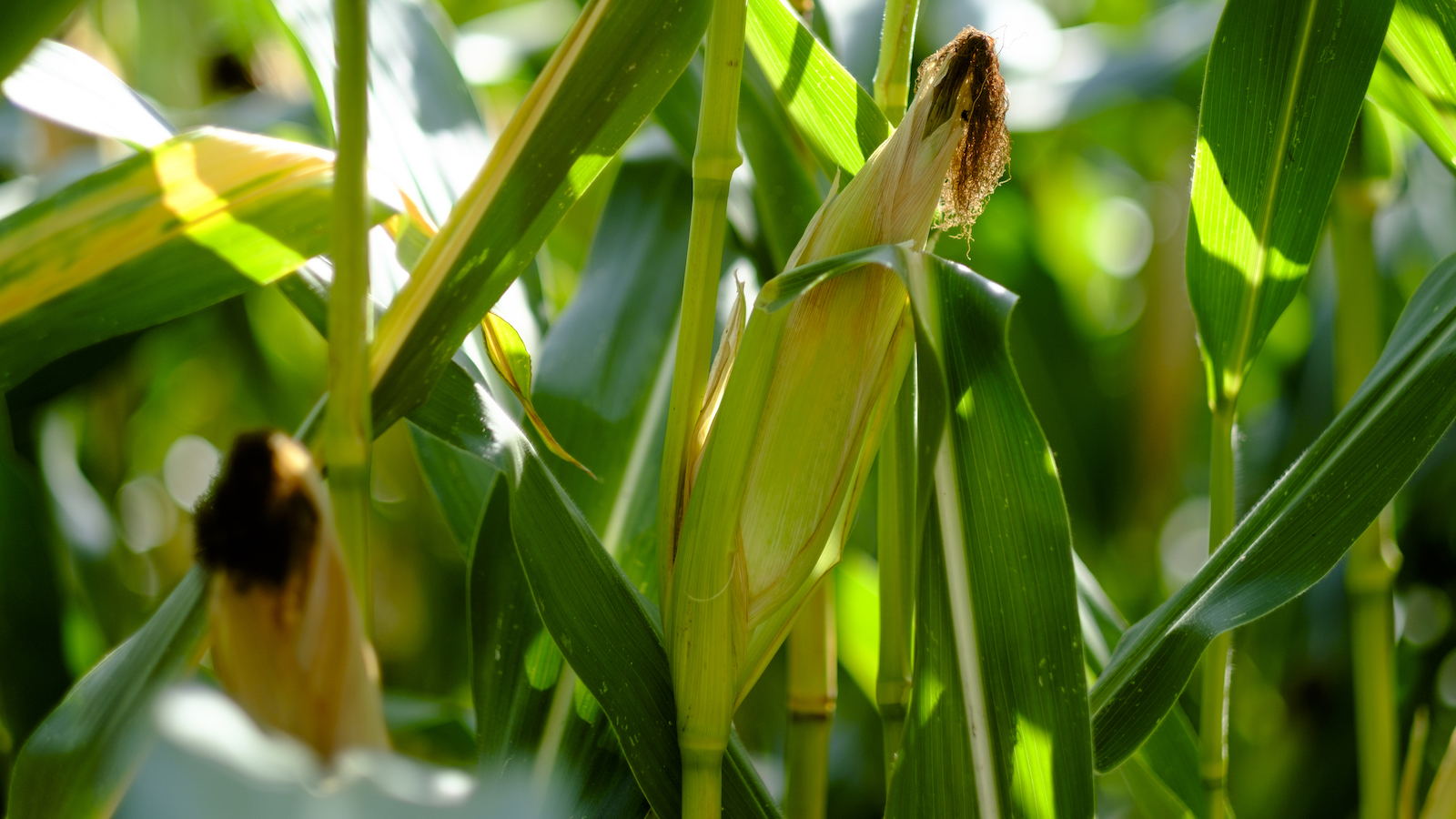This story was originally published by WIRED and is reproduced here as part of the Climate Desk collaboration.
If crops could feel envy, it’d be for legumes. Bean plants have a superpower. Or more accurately, they share one. They’ve developed symbiotic relationships with bacteria that process atmospheric nitrogen into a form that’s usable for those plants — an essential element for building their tissues, photosynthesizing, and generally staying healthy. This is known as nitrogen fixation. If you look at a legume’s roots, you’ll see nodules that provide these nitrogen-fixing microbes with a home and food.
Other crops — cereals like wheat, rice, and corn — don’t have such a deep symbiotic relationship, so farmers have to use large amounts of fertilizer to get the plants the nitrogen they need. This is very expensive. And fertilizer production is not great for the environment. It’s not easy to turn atmospheric nitrogen into a form of nitrogen that plants can absorb on their own.
“It takes a lot of energy and really high pressures and high temperatures,” says University of Illinois Urbana-Champaign plant biologist Angela Kent. “Bacteria do this at ambient temperatures and pressures, so they’re pretty special. While energy has been cheap, it’s been easy for us to overuse nitrogen fertilizers.”
Even worse, once it’s on fields, fertilizer spews nitrous oxide, which is 300 times as potent a greenhouse gas as carbon dioxide. Runoff from fields also pollutes water bodies, leading to toxic algal blooms. This is a particularly bad problem in the Midwest, where fertilizer empties into the Mississippi River and flows into the Gulf of Mexico, fueling massive blooms every summer. When those algae die, they suck the oxygen out of the water, killing any sea creatures unfortunate enough to be in the area and creating a notorious aquatic dead zone that can grow to be the size of New Jersey. Climate change is only exacerbating the problem, since warmer waters hold less oxygen to begin with.
Given all that nastiness, scientists have long been on a quest to reduce agriculture’s dependence on fertilizers by giving cereal crops their own nitrogen-fixing powers. And with the rise of gene-editing technology over the past few decades, that quest has been making progress. Last month, in the Plant Biotechnology Journal, researchers described a breakthrough with rice, engineering the plant to produce more compounds that encourage the growth of biofilms, which provide a cozy home for nitrogen-fixing bacteria, much like legumes provide nodules for their partner microbes.
“People for the last 30, 40 years have been trying to make cereals behave like legumes,” says Eduardo Blumwald, a plant biologist at the University of California, Davis who coauthored the new paper. “Evolution in that sense is very cruel. You cannot do in the lab what took millions and millions of years.”
So what’s with the evolutionary cruelty? Why can some plants — like, say aquatic ferns — fix nitrogen while others can’t?
It’s not that other species don’t get nitrogen at all. Cereal grasses use nitrogen that’s already in the soil — it comes from animal manure, as well as all the life churning in the dirt. (Lots of different bacterial groups process atmospheric nitrogen, not just the legumes’ symbionts.)
But the legumes’ bacteria grab abundant nitrogen straight from the air.
“When you have these nodules and you have this symbiotic relationship, it’s a much more effective way of getting atmospheric nitrogen,” says Joshua Doby, an ecologist at the University of Florida. “Because otherwise you have to wait for the bacteria and for other processes in the soil to turn it into ammonium.”
One theory is that the symbiotic nitrogen relationship started out long ago as a bacterial infection, and those ancestor plants derived a benefit that was carried through to future generations. Earlier this year, Doby published a study of plants throughout the United States, finding that there is a greater diversity of nitrogen-fixing species than other kinds in arid regions. That is true even if the soil isn’t nitrogen-poor. He theorizes that millions of years ago, when those areas were wetter, the plants evolved the ability to fix nitrogen, which also allowed them to grow thicker cuticles. This trait protected them against dryness when the region eventually became arid. They were pre-adapted, basically. Non-fixers, by contrast, were weeded out by rising aridity.
Another theory is that legumes might be consummate nitrogen-fixers because something in their genome predisposes them to building nodules.
But before you start feeling sorry for non-fixers, constructing nodules and hosting bacteria comes at a major cost. “It turns out that it’s very energetically expensive to actually do this,” says Ryan Folk, a biodiversity scientist at Mississippi State University who coauthored the new paper with Doby. First, a legume has to build those nodules on its roots, then it has to provide sugars to the bacteria to keep them happy.
“It’s something like 20 to 30 percent of the legumes’ photosynthetic output actually goes to the bacteria, so it’s an extraordinary price,” he says. So even though it’s less efficient for plants to get their organic nitrogen from bacteria already in the soil, it’s also less costly because symbiotic bacteria are super needy.
What Blumwald and his colleagues have done with rice is sort of halfway between the strategies of legumes and non-fixing plants. They sifted through compounds that the plant produces, testing which ones induced the formation of a biofilm.
“When bacteria form biofilms, it’s like a hippie commune — they are cozy, they are all together, they share things,” says Blumwald.
A complex layer of polysaccharides, proteins, and lipids covers the biofilm, which is not permeable to oxygen. That’s important because oxygen interferes with the bacteria’s fixing of nitrogen from the air — in legumes, the nodules keep the oxygen out.
The team landed on a biofilm-boosting compound called apigenin. They then used Crispr gene editing to silence the plant’s expression of an enzyme that breaks down this apigenin, allowing more of the compound to accumulate in the plant and extrude into the soil to create a biofilm.
“Then the bacteria started fixing nitrogen from the air to produce ammonium that the plant can uptake,” says Blumwald. “The proportion of nitrogen-fixing versus the rest of the bacteria near the root increased.” Basically, the rice plant now had its own fertilizer factory, giving it the nitrogen-fixing power denied to it by evolution.
This would seem to skirt a problem with previous attempts to get cereal crops to fix their own nitrogen, says Kent, the University of Illinois Urbana-Champaign plant biologist, who wasn’t involved in the research. People have tried to inoculate soils with nitrogen-fixing bacteria in the hope that the plants and microbes would form a partnership. But that’s been difficult, since the soil microbiome is a wildly complex ecosystem of competing bacteria.
“One thing I really liked about this paper is that it’s looking to modify the plants to make them partner with the soil microbiome better,” says Kent. “It helps to recruit the desired kind of microbes and give them a competitive advantage.”
Interestingly, scientists previously discovered a unique variety of corn in Mexico that fixes nitrogen in a similar way. The corn’s tube-shaped roots grow above ground, sheathing themselves in a bizarre mucilage — a whole lot of dripping goo. Like the biofilm around the rice roots, this mucilage houses nitrogen-fixing bacteria. The corn study authors think it would be possible to breed this trait into commercial varieties of corn.
Another problem with previous attempts with inoculation, Kent says, has been that the introduced bacteria can’t provide all the nitrogen the plants needed. A farmer would still have to apply fertilizer — but the over-application of fertilizer can actually overload natural nitrogen-fixers in the soil, sending them into hibernation. The field goes numb, essentially, as the beneficial microbiome shorts out.
A company called Pivot Bio is engineering nitrogen-fixing bacteria that don’t shut down in the presence of added nitrogen. “We break the genetic feedback loop that causes them to go into hibernation when fields get fertilized,” says Karsten Temme, the company’s CEO and cofounder.
Today, they’re launching new products in which these microbes are applied directly to seeds of corn, wheat, and other cereals. (With earlier products, they instead sprayed the bacteria as a liquid during seed planting.) Currently, the microbes can’t supply all the nitrogen these cereals need, so farmers may still need to fertilize. But Temme says the company is improving the microbes’ efficiency.
“What we see is there’s going to be a progression, where today we’re supplying a fraction of that nitrogen,” he says, “and over time, we begin to supply the majority and eventually the entirety of that nitrogen the crop needs.”
An effective biological nitrogen fixation system for rice could be “a game changer in global agriculture,” says Pallavolu Maheswara Reddy, who studies nitrogen fixation in cereals at India’s Energy and Resources Institute. That’s because the human population is growing rapidly, demanding more food and fertilizer to feed it.
“Since the advent of Green Revolution in the mid-1960s, the application of chemical nitrogen fertilizers boosted rice yields by 100 to 200 percent to match the demands of world population,” Reddy says. “In the next 30 years, we must produce nearly 50 percent more rice than what is currently produced to supplement the food requirements of an increasing human population.”
But even if scientists can just reduce the amount of fertilizer needed for agriculture, the industry would be saving some of the energy it takes to manufacture the stuff while cutting both farmers’ costs and the runoff that makes it into waterways. That’ll be especially important in parts of the world where climate change is making downpours more powerful (a warmer atmosphere in general holds more water), which will wash more fertilizer off of fields.
And just in case you’re worried about leagues of nitrogen-fixing plants spreading out of control thanks to their new superpower, Kent says there’s nothing to fear. “We don’t see legumes taking over the world,” says Kent. Nitrogen-fixing “is probably not the trait that a plant would need for becoming a super-plant.”




